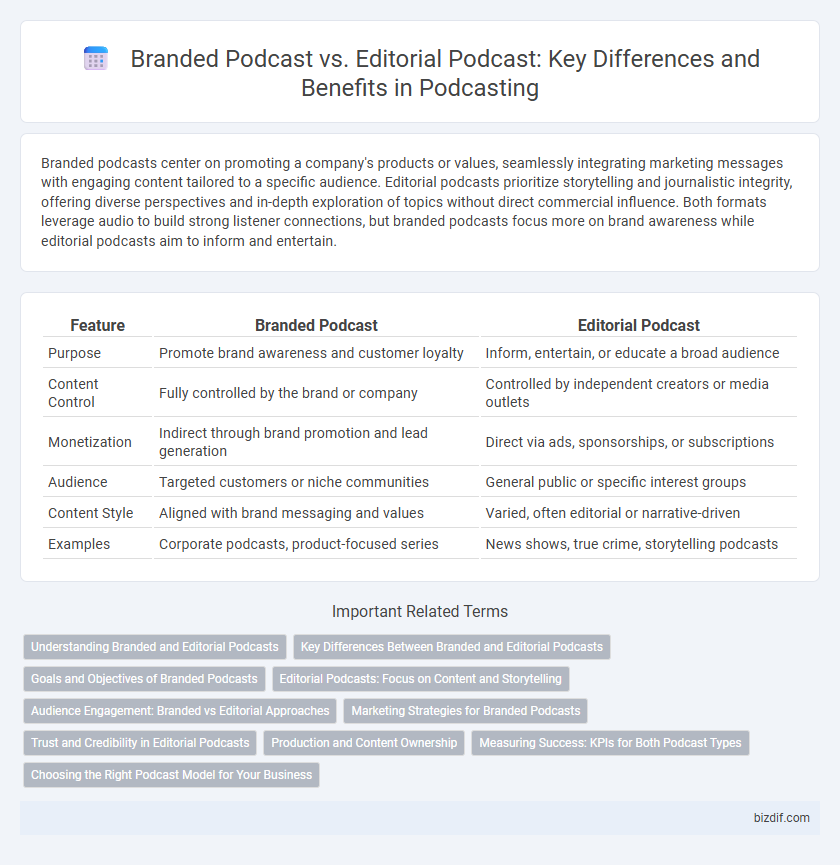Branded podcasts center on promoting a company's products or values, seamlessly integrating marketing messages with engaging content tailored to a specific audience. Editorial podcasts prioritize storytelling and journalistic integrity, offering diverse perspectives and in-depth exploration of topics without direct commercial influence. Both formats leverage audio to build strong listener connections, but branded podcasts focus more on brand awareness while editorial podcasts aim to inform and entertain.
Table of Comparison
| Feature | Branded Podcast | Editorial Podcast |
|---|---|---|
| Purpose | Promote brand awareness and customer loyalty | Inform, entertain, or educate a broad audience |
| Content Control | Fully controlled by the brand or company | Controlled by independent creators or media outlets |
| Monetization | Indirect through brand promotion and lead generation | Direct via ads, sponsorships, or subscriptions |
| Audience | Targeted customers or niche communities | General public or specific interest groups |
| Content Style | Aligned with brand messaging and values | Varied, often editorial or narrative-driven |
| Examples | Corporate podcasts, product-focused series | News shows, true crime, storytelling podcasts |
Understanding Branded and Editorial Podcasts
Branded podcasts serve as strategic marketing tools created by companies to promote their products, enhance brand awareness, and build customer loyalty through storytelling aligned with brand values. Editorial podcasts, produced by media organizations or independent creators, prioritize journalistic integrity and content quality, focusing on engaging, informative, or entertaining stories without direct commercial intent. Understanding the differences between branded and editorial podcasts is essential for marketers and producers to tailor content strategies that meet audience expectations and business objectives.
Key Differences Between Branded and Editorial Podcasts
Branded podcasts focus on promoting a company's products or values through storytelling aligned with marketing goals, while editorial podcasts prioritize unbiased content driven by audience interest and journalistic integrity. Key differences include content control, with branded podcasts offering brand-centric narratives and editorial podcasts delivering diverse perspectives often independent of brand influence. Distribution strategies also vary as branded podcasts typically integrate with broader marketing campaigns, whereas editorial podcasts rely on organic audience growth and editorial standards.
Goals and Objectives of Branded Podcasts
Branded podcasts focus on enhancing brand awareness, fostering customer loyalty, and driving targeted engagement by delivering content aligned with the company's values and products. Their primary goals include strengthening the brand identity, creating meaningful connections with the audience, and generating leads or sales through storytelling and strategic messaging. Branded podcasts often aim to position the company as an industry thought leader while supporting broader marketing and business objectives.
Editorial Podcasts: Focus on Content and Storytelling
Editorial podcasts prioritize high-quality content and compelling storytelling to engage listeners deeply, often featuring well-researched topics and diverse voices. Their primary goal is to inform, entertain, or inspire without overt commercial messaging, fostering authenticity and listener trust. This approach enhances audience loyalty and encourages organic growth, distinguishing editorial podcasts from branded ones focused on marketing objectives.
Audience Engagement: Branded vs Editorial Approaches
Branded podcasts leverage company values and product narratives to foster deeper audience engagement by creating targeted content that aligns with brand identity, resulting in higher listener loyalty and conversion rates. Editorial podcasts prioritize storytelling and independent journalistic integrity, attracting a broader audience through diverse topics and authentic discussions, which enhances trust and sustained interest. Both approaches drive engagement differently: branded podcasts capitalize on consistency and brand affinity, while editorial podcasts rely on content variety and credibility to connect with listeners.
Marketing Strategies for Branded Podcasts
Branded podcasts leverage storytelling to enhance brand identity, driving customer engagement through tailored content that resonates with target audiences. Marketing strategies for branded podcasts include integrating call-to-actions, cross-promoting on social media platforms, and collaborating with industry influencers to amplify reach. Data-driven approaches, such as audience segmentation and performance analytics, optimize content relevance and maximize return on investment.
Trust and Credibility in Editorial Podcasts
Editorial podcasts build trust and credibility by prioritizing unbiased content and authentic storytelling, which resonates deeply with listeners. Unlike branded podcasts that often serve promotional purposes, editorial podcasts maintain editorial independence, enhancing listener loyalty and perceived reliability. This commitment to transparency and journalistic integrity fosters a stronger connection and long-term audience engagement.
Production and Content Ownership
Branded podcasts are typically produced and controlled by companies, ensuring full ownership of the content and alignment with brand messaging, allowing for strategic marketing integration. Editorial podcasts are often created by independent producers or media organizations, granting greater creative freedom but with shared or external content ownership. Production in branded podcasts is usually more structured with a clear promotional goal, whereas editorial podcasts prioritize storytelling and audience engagement without direct commercial motives.
Measuring Success: KPIs for Both Podcast Types
Branded podcasts prioritize key performance indicators such as brand awareness, audience engagement, and lead generation to measure success, often tracking metrics like download numbers, listener demographics, and conversion rates. Editorial podcasts focus on content impact, listener retention, and social sharing, emphasizing listener feedback, episode completion rates, and reviews as critical KPIs. Both podcast types benefit from monitoring average listening duration and subscriber growth to gauge overall effectiveness and audience loyalty.
Choosing the Right Podcast Model for Your Business
Selecting the right podcast model depends on your business goals, with branded podcasts enhancing brand awareness and customer loyalty through targeted storytelling. Editorial podcasts prioritize content quality and audience engagement, often generating revenue via ads or subscriptions, suitable for thought leadership and community building. Assess your resources, audience preferences, and marketing objectives to determine whether a branded or editorial podcast aligns best with your strategic vision.
Branded Podcast vs Editorial Podcast Infographic

 bizdif.com
bizdif.com